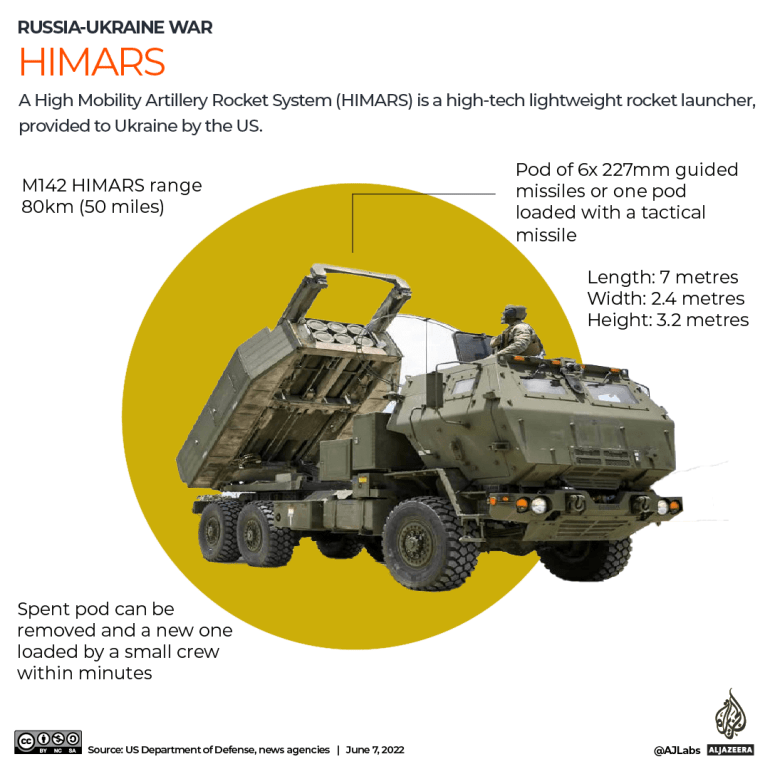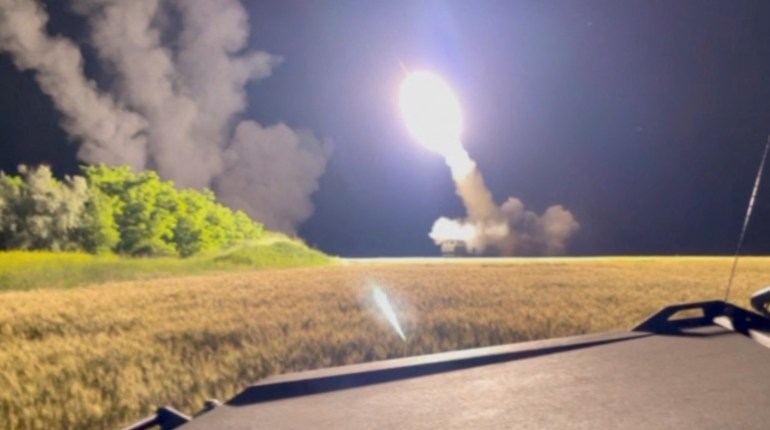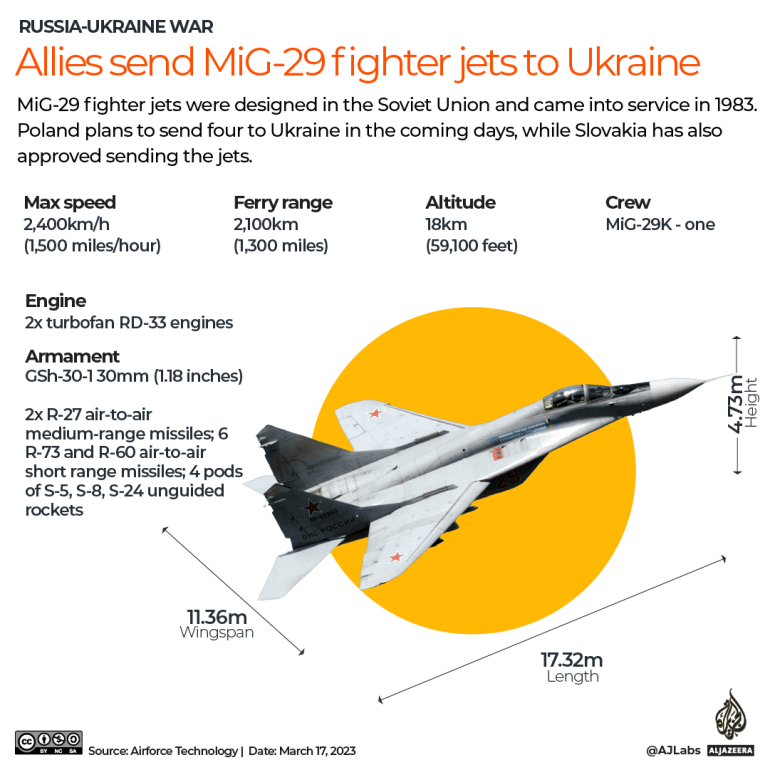Ukraine’s persistent lobbying of allies has yielded significant results as NATO members have gradually relented to supplying high-tech weapons.
The fighting in the coming weeks is likely to be bloody, as Ukraine aims to take back territory Russia took from it in the opening weeks of the invasion in 2022.
What are these weapons, and why are they needed?
Armoured punch
More than 230 Western main battle tanks have been transferred to Ukraine, including United States-made Abrams M1s and British Challenger 2s. But the vast majority are German-made Leopard 2 tanks.
These models are some of the world’s best in terms of firepower, protection and mobility – the tanks have been specifically designed to defeat Russia’s strongest battlefield efforts.
A potent combination of upgraded electronics, sensor suites and night-fighting abilities amplifies their abilities, giving commanders the means to detect and destroy Russian tanks at a far greater range than the enemy.
Why is this useful? They will be the armoured fist, at the tip of the counteroffensive, that will punch holes through enemy defences, exploiting gaps where they can, then wreak havoc behind Russian defensive lines – but they won’t be doing it alone.

Troop mobility
Advancing with and just behind the tanks will be mechanised infantry units, mainly using Infantry Fighting Vehicles like the US Bradley or German Marder.
Able to transport troops in relative safety, these vehicles are armed with a variety of 30mm cannon or anti-tank missiles and can defend themselves while providing supporting fire.
Hundreds of IFVs have been given by NATO members to Ukraine for this offensive, the most important so far of the war.
Ukrainian troops have taken intensive courses in fighting a modern war the NATO way, in addition to the tactical innovations the Ukrainians have already ably mastered for themselves. Speed will be key in advancing across the relatively flat, open spaces of southern Ukraine. To help them do that, artillery will come into play.
Vast volumes of 155mm ammunition have been stockpiled by both sides in anticipation of the coming battle. The thirst is colossal, with the Ukrainian military recently estimating it needs at least 12,000 shells per day to achieve its goals. Modern howitzers can fire these shells up to 30km (18.6 miles), but in a fast-moving conflict, targets deep behind Russian lines will have to be destroyed.
Enter HIMARS …
HIMARS and long-range artillery
One of the most effective weapons of the war so far is the High Mobility Artillery Rocket System or HIMARS. A precision-guided rocket system, it can fire a salvo with a 100kg (220.4 lbs) warhead that will land within metres of each other up to 80km (49.7 miles) away.
This gives it a serious punch as high-value targets can be utterly destroyed far behind the front lines.
Russian military logistics rely heavily on the rail system and marshalling yards and train depots make for very easy targets as they cannot be moved or changed.

HIMARS has been extremely efficient at destroying Russian fuel and ammunition depots, troop concentrations, and command and control centres as Ukraine has attempted to wear down Russia’s ability to conduct military operations.
The Russian military is not oblivious to this and has slowly pulled back its supply centres, where possible, and moved its command posts further back, beyond the range of HIMARS rockets.

Storm Shadow
The United Kingdom’s recent donation of hundreds of Storm Shadow cruise missiles will massively complicate Russian military plans.
Flying just under the speed of sound at treetop level, the stealthy cruise missile can deliver a 480kg (1058 lbs) “bunker buster” warhead with pinpoint accuracy over 250km (155.3 miles) away. It is sophisticated enough to fly around obstacles and areas that are heavily protected by air defence batteries.
It has an extremely small radar cross-section making it extremely hard to spot and track.
As it approaches, it climbs and dives down onto its target. The first of two charges blows a hole in the target, allowing the main charge to enter and detonate from inside, destroying it utterly.
It is designed to devastate high-value targets with little to no warning, regardless of whether they are reinforced or buried underground.
It will also be very effective against any large structure such as the vital Kerch Strait bridge, which has already been damaged in an earlier attack.
Ukraine may not have many of them, but if used carefully against major targets, they could very well tip the balance in the coming conflict, having given Ukraine the long-range punch it has always desired.
Airpower
All this will amount to very little if Ukraine cannot control the skies above the battlefield.
Despite President Volodymyr Zelenskyy’s regular pleas to the international community, no Western jets that have been promised are likely to arrive to make a difference in this battle.
What have been useful though, are the donations of MiG-29 Soviet legacy fighter jets from Slovakia and Poland that have made up for losses throughout the conflict.
Russia’s air force outnumbered Ukraine’s by more than four to one at the start of the war. It is one of the great surprises to observers of the conflict that Russia, despite an overwhelming advantage, failed dismally to destroy Ukraine’s air force in the opening days of the invasion.

The Ukrainian Air Force still flies sorties, bombs targets, and supports infantry more than a year later and this small but well-trained force will be of great use in the counteroffensive, providing support to ground troops and destroying targets of opportunity.
Of almost equal importance are the many types of drones flying over the battlefield. Now effectively used by both sides as artillery spotters and fire adjusters, accurate artillery strikes can be brought to bear in a matter of minutes now, making the open battlefield an even more dangerous place than it once was.
Small armed drones will drop charges on individual infantry positions while larger UAVs like the Bayraktar TB2s will search and hunt for easy targets like slow-moving or stationary radar stations.
Training
The weapons used are extremely important and can give Ukraine a significant edge, but the glue that binds all this together is the training undertaken, not just by infantry units but also by senior officers in the use of combined arms – the ability to use all these weapons together as one single entity, each reinforcing the abilities of the other, to provide a cohesive, whole military.
NATO members have been training cadres of officers, non-commissioned officers, and soldiers alike in the West’s way of conducting high-intensity offensive military operations.
Part of that has focused on air defence as Ukrainian units have learned to make the most of the vast array of complex air defence systems at their disposal.
This has already been effective in defending the capital, Kyiv, from a recent onslaught by Kinzhal hypersonic missiles and Shahed-136 drones, with the vast majority shot down.
A mix of complex weapons from all over the world will require the adept handling of logistics if the offensive is to keep up its momentum and supply and repair are vital for any advance to be successful. The Ukrainian military will have its work cut out for it. Russian forces have had months to prepare for the series of battles that could very well define the nature of the war.
Both sides realise what is at stake, and Russia will not give up its ground easily, despite talk of low morale among Russian forces.
